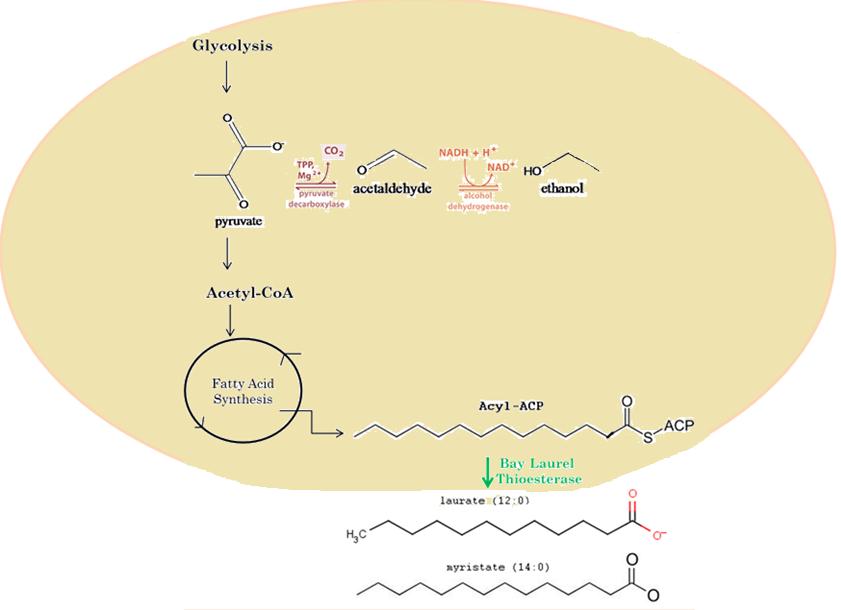Biodiesel
- Is well-studied and well-characterized; lots of past work in E. coli
- Past iGEM teams
- Nevada 2011: "A Cooperative Relationship Between Cyanobacteria and E.Coli for Production of Biofuels"
- separate populations of cyanobacteria and E. Coli
- http://2011.igem.org/Team:Nevada
- WISE 2011
- Nevada 2011: "A Cooperative Relationship Between Cyanobacteria and E.Coli for Production of Biofuels"
- difference between diesel and gasoline
- diesel freezes at a lower temperature than gasoline (used in Canadian cars)
- diesel doesn't need a spark; just need compression
- making gasoline is more complicated; more complicated mixture
- diesel is more efficient, but less powerful
- What is biodiesel:
- main component is sulfur ester
- fatty acid methyl esters (FAME)
- fatty acid ethyl esters (FAEE)
- pathway:
- glycolysis -> pyruvate -> acetyl coA -> Fatty acid synthesis -> fatty acid esters
- glycolysis -> pyruvate -> acetaldehyde -> ethanol
- How to get biodiesel out of cell?
- need to lyse cells?
- engineer bacteria to excrete it and then skim it off the top of the reactor? -E. coli exporters
- Bioenergy landscape
- Stephanopoulos Lab - http://bamel.scripts.mit.edu/gns/research/biofuels/
- UROP posting:
- Project Title: Synthetic Biology Approaches to the Isoprenoid Pathway for the Production of Drugs and Biofuels
- Contact: Steven Edgar (sedgar@mit.edu)
- UROP posting:
- Stephanopoulos Lab - http://bamel.scripts.mit.edu/gns/research/biofuels/
- Which genes? Where do we get them?
- Are they in the iGEM kit?
- How to measure?
- "The fatty acid and ethanol assays were quantitated by generating standard curves of absorbance vs substrate concentration using known quantities of palmitic acid or ethanol standards. "
Cellulose Degradation
cellulomonas fimi 4400 - gram positive
- many people have expressed its cellulose degradation enzyme in E. coli
couldn't find much on manipulating it
Cellvibrio japonicus 1000 - gram negative
possesses all the attributes necessary for efficient genetic manipulation, namely the ability to introduce foreign DNA, the presence of systems for gene overexpression and gene disruption via random and targeted methods.
the gentamycin resistant broad host range plasmid pBBR1-MCS5 replicates in C. japonicus. plasmids can be introduced by electrophoration.
efficiency is low though. conjugation can work too. targeted gene disruption can be carried out.
(functional genomics of cellvibrio japonicus, a book)
Cytophaga hutchinsonii 1200 - gram negative
C. hutchinsonii grows on minimal media with filter paper cellulose or glucose as the sole carbon and energy source and thus has the ability to synthesize all of its organic components from these substrates
C. hutchinsonii exhibits a form of rapid gliding motility whose mechanism remains unexplained despite decades of study (43, 64, 72).
Gliding may help to facilitate cellulose digestion, since gliding cells align themselves with and move along cellulose fibers as they digest them
The identification of a system of gene transfer, a selectable marker, a suicide vector, and a transposon that functions in these diverse bacteria allows genetic manipulations to be performed.
- QUESTIONS TO ANSWER:
- Mechanism of digesting the cellulose? Which metabolites are produced? Which enzymes used?
- Cellulose degradation system of Cytophaga hutchinsonii: https://www.era.lib.ed.ac.uk/handle/1842/7657
- plausibility of a co-culture with E. coli
- Genetic tools
- how to measure cellulose -> ?
- Mechanism of digesting the cellulose? Which metabolites are produced? Which enzymes used?
Project Structure
- Group 1: cellulose -> intermediate via ?
- growth conditions
- measure byproducts and intermediate metabolites
- growth dynamics
- effects of pH, temperature, feed stock, inhibitory byproducts
- Ubq ligase + Ab -> knockdown
- genetic manipulations (e.g. can we express GFP?)
- Group 2: intermediate -> biodiesel via E. coli
- effects of pH, temperature, intermediates from bacteria #1, inhibitory byproducts
- measure biodiesel (make an assay?)
- Biodiesel transporter: measure internal and external FAEE
- Which genes turn intermediates into biodiesel? construction of plasmids? regulation of genes?
